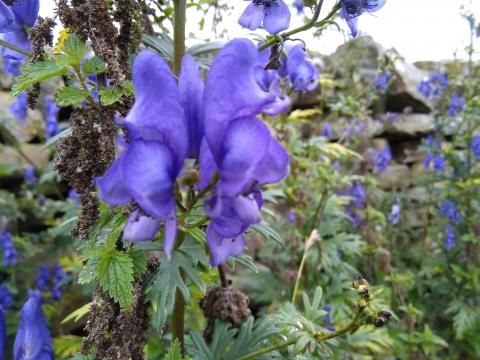Monkshood

What is this pretty flower? I snapped it as I returned from visiting a sick member of the congregation. Monkshood was the name my research yielded. I could see how its petals came by such a name, and conjured images of cowled, kindly monks walking about. Yet the plant has other names, descriptive of its qualities rather than its flower’s appearance: wolf's-bane, leopard's bane, mousebane, women's bane, devil's helmet, and queen of poisons.
According to the Online Eymological Dictionary, 'bane' comes
from Old English bana "killer, slayer, murderer, a worker of death"…also "the devil," from Proto-Germanic banon, cognate with banja- "wound" (source also of Old Frisian bona "murderer," Old Norse bani "death; that which causes death," Old High German bana "death, destruction," Old English benn "wound," Gothic banja "stroke, wound").
You get the idea. Taken in sufficient quantity, it kills mice, wolves, leopards and women. Or just anything and anyone who takes it, small or great. That so lovely a flower should come from so toxic a plant! Ingesting it can kill within just a few hours, whereas merely touching it may cause a 'coldness' in the fingers, headaches and nausea.
So often, it is the lovely, pretty and desirable things in life which prove so lethal. Hedonism, gambling, heavy drinking, irreligion, busyness, independence- all of them might appear attractive, but they only lead to death.
But their vynes are of the vynes of Sodom and of the feldes of Gomorra. Their grapes are grapes of gall, and theire clusters be bytter. Deut 32:32. Tyndale's translation, 1526
- Log in to post comments


 Sunday Worship 10.45am & 6.00pm
Sunday Worship 10.45am & 6.00pm